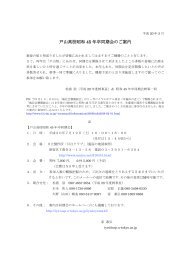Hofstadter butterflies in a modulated magnetic field - APS Link ...
Hofstadter butterflies in a modulated magnetic field - APS Link ...
Hofstadter butterflies in a modulated magnetic field - APS Link ...
- No tags were found...
You also want an ePaper? Increase the reach of your titles
YUMPU automatically turns print PDFs into web optimized ePapers that Google loves.
IYE et al. PHYSICAL REVIEW B 70, 144524 (2004) n = te −ik x a n−1 + te ik x a n+1 +2t cosk y a −2n n .3When is a rational number p/q, p and q be<strong>in</strong>gmutually prime, the size of the <strong>magnetic</strong> unit cell becomesqa,a, namely, x+qa,y=x,y and x,y+a=x,y.Figure 1 shows the tight-b<strong>in</strong>d<strong>in</strong>g square lattice withthe choice of gauge appropriate to = p/q. The energyeigenvalues are obta<strong>in</strong>ed by diagonaliz<strong>in</strong>g the follow<strong>in</strong>gmatrix:2t cosk y a −2 te ik x a 0 ¯ 0 e −ik x ate −ik x a 2t cosk y a −4 te ik x a 0 ¯ 00 4 0 00 ¯ 0 te −ik x a 2t cosk y a −2q −1 te ik x ate ik x a 0 ¯ 0 te −ik x a 2t cosk y a −2q.The result is the well-known butterfly spectrum, shown <strong>in</strong>the topmost panel of Fig. 3.B. Checkerboard <strong>magnetic</strong> <strong>field</strong>We consider a spatially vary<strong>in</strong>g <strong>magnetic</strong> <strong>field</strong> whichconsists of a uniform component and a component vary<strong>in</strong>g<strong>in</strong> a checkerboard pattern, as shown <strong>in</strong> Fig. 2. Here, denotes the flux per plaquette of the uniform componentof the <strong>magnetic</strong> <strong>field</strong>, and denotes the flux per plaquettewhich alternates <strong>in</strong> sign <strong>in</strong> the checkerboard pattern. Theassignment of the Peierls phase factor for this flux patternis shown <strong>in</strong> the figure. For = p/q, the system is <strong>in</strong>variantunder translation 2qa,0 or a,a. The relevant Schröd<strong>in</strong>gerequation reads n,m = t n−1,m + t n+1,m + te −2<strong>in</strong>−m+1 n,m−1+ te 2<strong>in</strong>−m e 2i n,m+1 n − m odd, 5 n,m = t n−1,m + t n+1,m + te −2<strong>in</strong>−m+1 e 2i n,m−1+ te 2<strong>in</strong>−m n,m+1 n − m even.Spectra obta<strong>in</strong>ed by diagonalization of the correspond<strong>in</strong>g2q2q matrix are shown <strong>in</strong> Fig. 3. The spectra are symmetricwith respect to transformations, →1±, so that calculationover the range =0– 1 2suffices. Five panels <strong>in</strong> Fig. 3correspond to =0, 1 8 , 1 4 , 3 8 , and 1 2, respectively. The topmostpanel =0 is the orig<strong>in</strong>al <strong>Hofstadter</strong> butterfly spectrum.Introduction of nonzero deforms the spectrum <strong>in</strong> such away that, for <strong>in</strong>stance, the spectral weight at the band center(van Hove s<strong>in</strong>gularity at =0) for =0 is smeared, and aquasigap develops there with <strong>in</strong>creas<strong>in</strong>g . The bottommostpanel = 1 2is identical to the topmost one except that thespectrum is shifted by 1 2along the horizontal axis. Thatthis should be so can be readily understood by recall<strong>in</strong>g thefollow<strong>in</strong>g: At = 1 2 , two adjacent cells enclose + 1 2 and − 1 2flux, respectively. Addition of a uniform flux = 1 2to thesystem changes them to 1 and 0, which is equivalent to the=0,=0 configuration. The same relation (shift by halfperiod)holds between the spectra for = 3 8[panel (d)] andfor = 1 8 [panel (b)].At= 1 4[panel (c)], the periodicity <strong>in</strong> becomes half the orig<strong>in</strong>al one. In other words, the states at=<strong>in</strong>teger and at =half-<strong>in</strong>teger become equivalent for= 1 4. Aga<strong>in</strong>, this can be easily understood by recall<strong>in</strong>g thatthe flux configuration of two adjacent cells is +34 ,+1 4at= 1 4 ,= 1 2, which is equivalent to −14 ,+1 4, and hence to +14 ,−1 4at = 1 4 ,=0 .FIG. 1. Tight-b<strong>in</strong>d<strong>in</strong>g square lattice with assignment of thePeierls phase factor to each bond, for a uniform external <strong>magnetic</strong>flux = p/q.FIG. 2. Square lattice subjected to a spatially vary<strong>in</strong>g <strong>magnetic</strong><strong>field</strong> <strong>in</strong> a checkerboard pattern and a uniform <strong>field</strong> .The assignment of the Peierls phase factor is <strong>in</strong>dicated bythe arrows.144524-2








